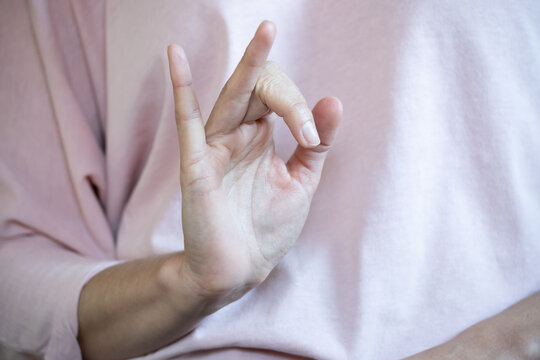Mudras are symbolic hand gestures used in yoga and meditation to influence the flow of prana (life energy) and cultivate specific mental, emotional, and spiritual states. Among the various hand mudras, Vishnu Mudra holds a special place in the practice of pranayama, particularly in Nadi Shodhana or alternate nostril breathing.
Named after Lord Vishnu, the preserver in the Hindu Trinity, this mudra symbolizes balance, harmony, and preservation. It is designed to facilitate the controlled alternation of breath between the nostrils, balancing the body’s energy channels (nadis) and calming the nervous system.
Table of Contents
Meaning and Symbolism:
- Vishnu represents order, balance, and sustenance all qualities mirrored in the effects of this mudra.
- The mudra assists in regulating breath, which is deeply connected to controlling thoughts, emotions, and pranic flow.
- It symbolizes the duality and unity of life left and right, masculine and feminine, yin and yang achieved through breath balance.
How to Perform Vishnu Mudra
Use the right hand for Vishnu Mudra. Here’s how:
- Fold the index and middle fingers of the right hand into the palm.
- Keep the thumb, ring finger, and little finger extended.
- Use the thumb to close the right nostril, and the ring finger (or sometimes ring + little finger) to close the left nostril.
- The mudra is typically held in front of the nose during alternate nostril breathing (Nadi Shodhana).
Uses of Vishnu Mudra:
- Exclusively used in Nadi Shodhana Pranayama and its variations.
- Can also be applied in Anulom Vilom, a similar form of alternate nostril breathing.
- Occasionally used in advanced breath retention practices to balance the flow of prana in the ida and pingala nadis (left and right energy channels).
Benefits of Vishnu Mudra:
The benefits of Vishnu Mudra are…
- Balances left and right brain hemispheres, enhancing concentration and mental clarity.
- Reduces stress and anxiety by calming the autonomic nervous system.
- Improves emotional regulation and mood stability.
- Supports the respiratory system by regulating the breath and strengthening lung function.
- Helps in cleansing the nadis (energy channels), improving overall pranic circulation.
- Can aid in lowering blood pressure and heart rate, promoting cardiovascular health.
- Harmonizes ida and pingala nadis, activating the central sushumna nadi (main energy channel).
- Prepares the practitioner for deeper meditation and Kundalini awakening.
- Symbolizes inner balance, purity, and alignment with higher consciousness.
Precautions and Best Practices:
- Always use the right hand for forming Vishnu Mudra during pranayama.
- Avoid practicing right after eating or during illness.
- Sit in a quiet, well-ventilated place.
- For beginners, start with simple breath awareness before moving into full alternate nostril breathing.
- Individuals with serious respiratory or cardiac conditions should consult a medical professional before intensive pranayama practices.
Vishnu Mudra is more than just a physical hand position; it is a symbolic and practical tool that supports deep transformation in yoga and pranayama. By harmonizing the flow of breath and balancing the body’s energy systems, it aligns us with the qualities of Lord Vishnu—balance, preservation, and inner peace.
Simple in form yet profound in impact, Vishnu Mudra invites practitioners into a space of inner harmony, stillness, and spiritual integration. Whether you are new to pranayama or an experienced yogi, incorporating this sacred gesture into your practice can deepen your connection to both breath and being.
FAQ:
Q. What is Vishnu Mudra?
A. Vishnu Mudra is a yogic hand gesture primarily used during Nadi Shodhana Pranayama (alternate nostril breathing). It involves folding the index and middle fingers of the right hand and using the thumb and ring finger to alternately close the nostrils.
Q. Why is it called Vishnu Mudra?
A. It is named after Lord Vishnu, the preserver in the Hindu trinity, symbolizing balance, order, and harmony qualities that this mudra seeks to instill through breath regulation and energy balancing.
Q. Which pranayama is Vishnu Mudra used for?
A. It is mainly used in:
- Nadi Shodhana (alternate nostril breathing)
- Anulom Vilom (a simplified form of alternate nostril breathing)
Q. Can I use my left hand for Vishnu Mudra?
A. Traditionally, only the right hand is used for this mudra. The left hand can rest on the knee in Chin or Jnana Mudra during practice.
Q. What are the benefits of Vishnu Mudra?
A. When used in pranayama, Vishnu Mudra helps:
- Calm the mind and reduce stress
- Balance the nervous system
- Purify energy channels (nadis)
- Support lung and heart function
- Enhance mental clarity and emotional stability
Q. How long should I hold Vishnu Mudra during practice?
A. Hold it throughout your alternate nostril breathing session, which can range from 5 to 20 minutes, depending on your experience and comfort level.
Q. Is Vishnu Mudra safe for beginners?
A. Yes. It’s very beginner-friendly. However, ensure:
- You sit comfortably
- Breathe gently and mindfully
- Avoid overexerting or forcing the breath
Q. Can I do Vishnu Mudra outside of pranayama?
A. Vishnu Mudra is specifically designed for breath control techniques and is not typically used during meditation or other yoga practices. For general meditation, Chin or Jnana Mudra is more appropriate.
Q. Does Vishnu Mudra have any contraindications?
A. It is generally safe, but:
- Avoid if you have severe nasal congestion or respiratory infections
- Do not strain your breath or lungs
- People with serious heart or lung conditions should consult a healthcare provider before doing intensive pranayama





